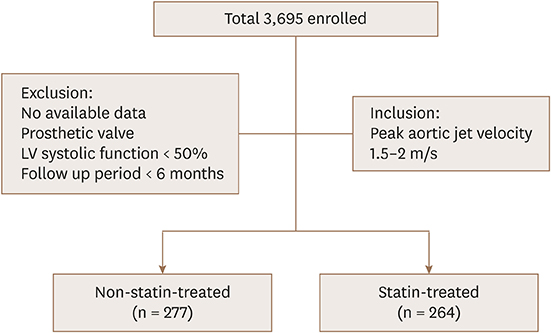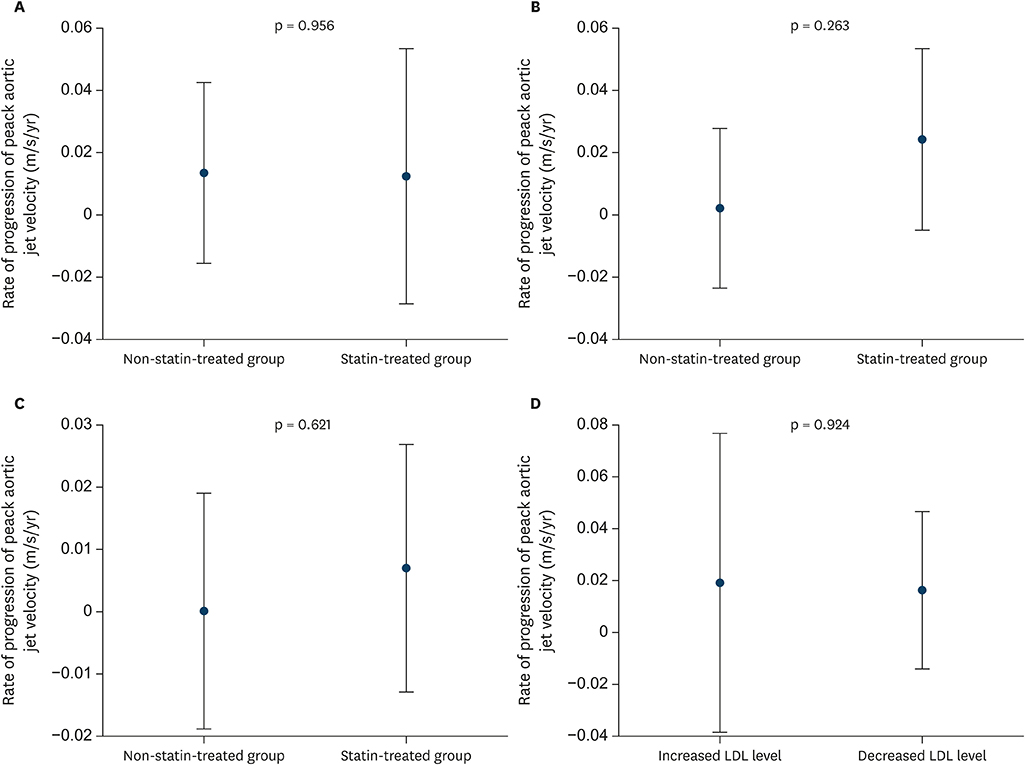J Cardiovasc Imaging.
2018 Dec;26(4):229-237. 10.4250/jcvi.2018.26.e27.
Statins Have No Role in Preventing the Progression of Aortic Valve Sclerosis
- Affiliations
-
- 1Department of Internal Medicine, Kangwon National University Hospital, Chuncheon, Korea.
- 2Division of Cardiology, Department of Internal Medicine, Kangwon National University Hospital, Kangwon National University School of Medicine, Chuncheon, Korea. rdr0203@hanmail.net
- KMID: 2429998
- DOI: http://doi.org/10.4250/jcvi.2018.26.e27
Abstract
- BACKGROUND
Statins are thought to have little effect on the progression of aortic stenosis, but the data on their role in patients with aortic valve sclerosis (AVS) are limited and inconsistent.
METHODS
We retrospectively analyzed 541 consecutive patients (214 men, age: 70 ± 11 years) with AVS. Each patient underwent two or more electrocardiography examinations at least 6 months apart at Kangwon National University Hospital from August 2010 to August 2015. AVS is defined as irregular thickening of the leaflets, focal increases in echogenicity and minimal elevation of the peak aortic valve velocity (> 1.5 and < 2 m/s). The progression rate of AVS was expressed as the increase in peak velocity per year (m/s/yr).
RESULTS
The mean follow-up duration was 24.9 ± 13.3 months in the statin-treated group and 24.1 ± 12.4 months in the non-statin-treated group (p = 0.460). There were no differences between the statin-treated and non-statin-treated groups in mean age, gender or smoking status. Relative to the non-statin-treated group, a higher number of patients in the statin-treated group had hypertension, diabetes, ischemic heart disease, and stroke. The progression rate of AVS did not differ between the statin-treated and non-statin-treated groups (0.012 ± 0.340 m/s/yr vs. 0.014 ± 0.245 m/s/yr, p = 0.956). Multivariate analysis showed initial peak aortic jet velocity was significantly associated with AVS progression (β = 0.153, p = 0.009).
CONCLUSIONS
Our study demonstrated that statins had no effect on the progression of AVS. However, well-designed studies are needed to define the prognosis and management of AVS.
Keyword
MeSH Terms
Figure
Reference
-
1. Freeman RV, Otto CM. Spectrum of calcific aortic valve disease: pathogenesis, disease progression, and treatment strategies. Circulation. 2005; 111:3316–3326.2. Lindroos M, Kupari M, Heikkilä J, Tilvis R. Prevalence of aortic valve abnormalities in the elderly: an echocardiographic study of a random population sample. J Am Coll Cardiol. 1993; 21:1220–1225.
Article3. Rossebø AB, Pedersen TR. Hyperlipidaemia and aortic valve disease. Curr Opin Lipidol. 2004; 15:447–451.
Article4. Wierzbicki A, Shetty C. Aortic stenosis: an atherosclerotic disease? J Heart Valve Dis. 1999; 8:416–423.5. Liebe V, Brueckmann M, Borggrefe M, Kaden JJ. Statin therapy of calcific aortic stenosis: hype or hope? Eur Heart J. 2006; 27:773–778.
Article6. Rajamannan NM, Subramaniam M, Springett M, et al. Atorvastatin inhibits hypercholesterolemia-induced cellular proliferation and bone matrix production in the rabbit aortic valve. Circulation. 2002; 105:2660–2665.
Article7. Akin I, Nienaber CA. Is there evidence for statins in the treatment of aortic valve stenosis? World J Cardiol. 2017; 9:667–672.
Article8. Antonini-Canterin F, Popescu BA, Huang G, et al. Progression of aortic valve sclerosis and aortic valve stenosis: what is the role of statin treatment? Ital Heart J. 2005; 6:119–124.9. Hamilton AM, Boughner DR, Drangova M, Rogers KA. Statin treatment of hypercholesterolemic-induced aortic valve sclerosis. Cardiovasc Pathol. 2011; 20:84–92.
Article10. Memon S, Ganga HV, Masrur S, Thompson PD. The effect of HMG CoA reductase inhibitors on the progression of aortic sclerosis: review article. Conn Med. 2016; 80:169–174.11. Baumgartner H, Hung J, Bermejo J, et al. Echocardiographic assessment of valve stenosis: EAE/ASE recommendations for clinical practice. J Am Soc Echocardiogr. 2009; 22:1–23.
Article12. Aronow WS, Ahn C, Kronzon I, Goldman ME. Association of coronary risk factors and use of statins with progression of mild valvular aortic stenosis in older persons. Am J Cardiol. 2001; 88:693–695.
Article13. Bellamy MF, Pellikka PA, Klarich KW, Tajik AJ, Enriquez-Sarano M. Association of cholesterol levels, hydroxymethylglutaryl coenzyme-A reductase inhibitor treatment, and progression of aortic stenosis in the community. J Am Coll Cardiol. 2002; 40:1723–1730.
Article14. Novaro GM, Tiong IY, Pearce GL, Lauer MS, Sprecher DL, Griffin BP. Effect of hydroxymethylglutaryl coenzyme a reductase inhibitors on the progression of calcific aortic stenosis. Circulation. 2001; 104:2205–2209.
Article15. Rosenhek R, Rader F, Loho N, et al. Statins but not angiotensin-converting enzyme inhibitors delay progression of aortic stenosis. Circulation. 2004; 110:1291–1295.
Article16. Moura LM, Ramos SF, Zamorano JL, et al. Rosuvastatin affecting aortic valve endothelium to slow the progression of aortic stenosis. J Am Coll Cardiol. 2007; 49:554–561.
Article17. Rossebø AB, Pedersen TR, Boman K, et al. Intensive lipid lowering with simvastatin and ezetimibe in aortic stenosis. N Engl J Med. 2008; 359:1343–1356.
Article18. Cowell SJ, Newby DE, Prescott RJ, et al. A randomized trial of intensive lipid-lowering therapy in calcific aortic stenosis. N Engl J Med. 2005; 352:2389–2397.
Article19. Chan KL, Teo K, Dumesnil JG, Ni A, Tam J. Effect of Lipid lowering with rosuvastatin on progression of aortic stenosis: results of the aortic stenosis progression observation: measuring effects of rosuvastatin (ASTRONOMER) trial. Circulation. 2010; 121:306–314.20. Parolari A, Tremoli E, Cavallotti L, et al. Do statins improve outcomes and delay the progression of non-rheumatic calcific aortic stenosis? Heart. 2011; 97:523–529.
Article21. Antonini-Canterin F, Hîrşu M, Popescu BA, et al. Stage-related effect of statin treatment on the progression of aortic valve sclerosis and stenosis. Am J Cardiol. 2008; 102:738–742.
Article22. Ryu DR, Park SJ, Han H, et al. Progression rate of aortic valve stenosis in Korean patients. J Cardiovasc Ultrasound. 2010; 18:127–133.
Article23. Sashida Y, Rodriguez CJ, Boden-Albala B, et al. Ethnic differences in aortic valve thickness and related clinical factors. Am Heart J. 2010; 159:698–704.
Article24. Palta S, Pai AM, Gill KS, Pai RG. New insights into the progression of aortic stenosis: implications for secondary prevention. Circulation. 2000; 101:2497–2502.
Article25. Bahler RC, Desser DR, Finkelhor RS, Brener SJ, Youssefi M. Factors leading to progression of valvular aortic stenosis. Am J Cardiol. 1999; 84:1044–1048.
Article26. Rosenhek R, Binder T, Porenta G, et al. Predictors of outcome in severe, asymptomatic aortic stenosis. N Engl J Med. 2000; 343:611–617.
Article
- Full Text Links
- Actions
-
Cited
- CITED
-
- Close
- Share
- Similar articles
-
- Tuberous Sclerosis with Aortic Aneurysm and Rib Changes
- Expanding transcatheter aortic valve replacement into uncharted indications
- Correlation between Lipoprotein(a) and Abdominal Aorta Thickness and Aortic and Mitral Valve Sclerosis
- Quadricuspid Aortic Valve : Report of Three Cases and Review of the Literature
- A Case of 51 Year Old Woman with Quadricuspid Aortic Valve Associated with Regurgitation



